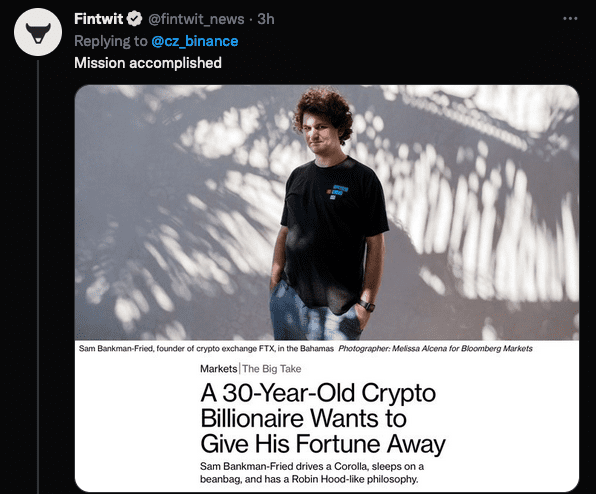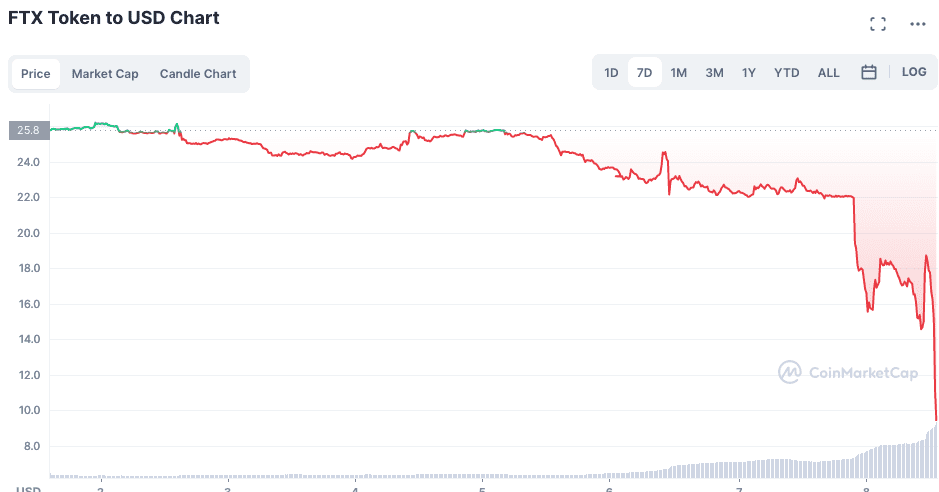Tuesday afternoon Binance CEO Changpeng Zhao took to Twitter to announce an agreement to buy FTX.com, the non-U.S. section of Sam Bankman-Fried’s FTX.
“This afternoon, FTX asked for our help,” Zhao began.
Zhao said that Binance could still pull out of the deal whenever they wanted, and it was pending agreement and audit.
Say it ain’t so
After denying allegations that the exchange was insolvent on Monday, Bankman-Fried said in a tweet that the agreement was a go, and things had come full circle. FTX’s native exchange token, FTT, dropped more than 50% on the news.
Binance is the largest exchange by volume in the world, and Timo Lehes, the co-founder of the Swarm DeFi platform, said the consolidation would make Binance too big to fail.
“Their success is now crucial to the systemic operations of the crypto industry, given that more than half of global spot trades and a large chunk of crypto derivatives business is transacted across both exchanges,” Lehes said. “It is no secret that Binance is trying to increase its regulatory footprint and the FTX acquisition advances that strategy.”
What a week
Last week, CoinDesk reported the balance sheet of FTX’s sister company Alameda Research showed a large holding of the FTT token. Alameda Research is the trading counterpart to FTX, also founded by Bankman-Fried, and according to unpublished documents, connected like twins through tokens.
According to a private document that CoinDesk did not post online, at the end of June, Alameda had $14.6 billion AUM, including “$3.66 billion of ‘unlocked FTT,’ $2.16 billion of “FTT collateral, and $292 million of ‘locked FTT.'” Nearly half of the firm has funds tied up in its sister, reminding many readers of the Terra Luna collapse in May. Binance said it had $2.1 billion in FTT ready to sell.
Zhao said he would dump Binance holdings in FTT to the concern of the entire industry. Lehes said that the action shut down a large portion of the exchange’s liquidity to the point that they had to shut down withdrawals. He said the takeover was opaque and centralized.
“The deal’s timing is interesting as it comes less than 24 hours after Binance pulled its liquidity from FTX,” he said. “The events of the last 24 hours highlight the lack of transparency as a centralized phenomenon.”

FTX a ‘Lehman moment’
On Monday, Bankman-Fried wrote that the default rumors were false.
“A competitor is trying to go after us with false rumors. FTX is fine. Assets are fine,” he said.
David Weisberger, the CEO, and Co-Founder of CoinRoutes, a trading platform that runs $60 billion through exchanges per year, said if FTX made loans collateralized in FTT, it would be a classic balance sheet hole that they have no hope to pay back.
“The market is pricing FTT that way, and the selloffs in bitcoin and ethereum indicate that many players feel this is a potential Lehman moment for crypto. Unlike Lehman, however, FTX promoted itself as an agency platform that didn’t take big risks beyond its liquidation engine.”
So much for an industry powerhouse
With Bankman-Fried as a leader, FTX enjoyed consumer confidence and stability as an industry powerhouse during a complicated 2022.
During the crashes in the spring, FTX and Bankman-Fried bought out failing brands like Voyager and BlockFi for $240M and a $400M line of credit.
The exchange giant even showed interest in an acquisition of Robinhood after an initial purchase of a 7.6% stake in May.

After losing confidence, bitcoin, Solana, and ethereum fluctuated wildly while Bnb stayed put.
“Alameda, the affiliated trading firm was supposedly where the risks were being taken, and the relationship between the two firms has been an area of intense speculation for some time,” Weisberger said. “If it turns out that Alameda lost money and FTX loaned them money with FTT as collateral, that will be seen as problematic and potentially worse.
‘Clash of the titans’
Ryan Shea, Crypto Economist at Trakx, said the same in a blog post, ‘Clash of the Titans,’ he wrote just 24 hours before a crash. He said the outstanding supply of FTT was far less than the leaked exposure on Alameda’s balance sheet.
“The outstanding circulating supply of FTT is only around $3 billion,” Shea said. “The price that the assets are marked on Alameda’s balance sheet looks less like mark-to-market and more like mark-to-myth as it would be impossible to liquidate their FTT at anything like the price marked.”
He said critics had made quick comparisons to Celsius Network and LUNA. Timothy Li, CEO of Alchemy and Web3 entrepreneur, replied in a LinkedIn post simply, “Truth is stranger than fiction.”
Still, FTX claimed it was solvent, and Bankman-Fried took to Twitter Monday to say they have $1 billion in cash reserves. The CEO of Alameda, Caroline Ellison was back and forth in a public discussion with Binance all week, and tweeted late Sunday they would buy back FTT from Binance at $22 a coin, the current market price. The coin is now hovering toward $4.
A laundry list of problems
As Miles Deutscher, a DeFi trader and analyst, pointed out those departers were among many items in a laundry list of concerns leading up to the Binance takeover.
FTX faced an SEC inquiry, while Bankman-Fried busied himself donating to political campaigns and speaking out in favor of a DeFi bill that many argued hurt the industry.
In a trending response, Custodia Bank CEO Caitlyn Long posted a talk from Bitcoin 2021 where she spoke out against crypto-leveraged assets long before the blow-up began.
“Even those of us that are not leveraged have the downside,” Long said. “A fool and his leveraged bitcoin are soon parted.”
She told Fintech Nexus to pay attention to the last portion of the clip, where she said avoiding fractionalized banking is a commitment to solvency rather than liquidity.
“Liquidity is nice to have for a store of value but not a necessity,” she said.
She was on a panel with Bankman-Fried, who said that avoiding leverage could be a good strategy but reminded the crowd where the bitcoin price jump to $60K came from in the first place.
“You can’t just look at the draw from $60K to $40K was about leverage, when the run-up $10K to $40K was done with leverage,” he said. “Think about what you’re throwing out with the bad parts; think about the collateral damage.”
Outbound funds frozen
According to analysts at The Block, the last outgoing transaction from FTX on the ethereum Tron and Solana was at 6:37 a.m. ET.

Eric Newcomer, a top tech Substack writer, commented on the great loss in value felt by FTX investors.
“Sequoia invested in a $420m round in FTX at a $25B valuation in October 2021, and a consortium with Paradigm invested $400M at $32B in January 2022. And now it’s selling in a fire sale? This is a truly crazy event in the startup world. Dot-com bust-level event”
Paradigm responded to Fintech Nexus outreach through their public tweet: “Just want to say that the FTX team have been awesome to work with, and we look forward to growing our very awesome partnership once all this FUD blows over,” the public Paradigm account said. “Sending good vibes.”
Bankman-Fried quickly tweeted that the sale would only account for the non-U.S. side of FTX.
In a 2021 audit report CNBC read privately and did not post online, FTX.us accounted for just 5% of the $1 billion of its revenue as cryptocurrencies hit an all-time high.
Related:
— With files from Isabelle Castro.


